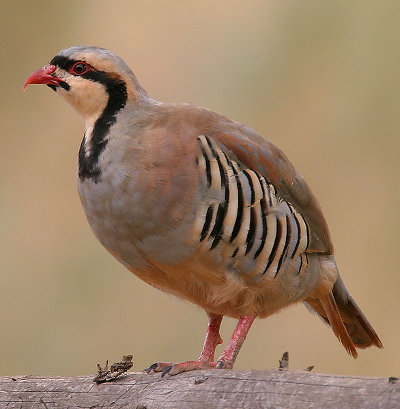Chukar Partridge
Category: Game Birds

The Chukar Partridge is a game bird that comes from the genus Alectoris of the family Phasianidae. The binomial name of this bird is Alectoris Chukar and it is a Eurasian moorland bird. The Chukar Partridge variety has been measured to structure a super species complex, together with the Philby's Partridge, Rock Partridge, and the Przevalski's Partridge and considered as Conspecific during the past, chiefly with the first. The Chukar Partridge has been introduced into countless other places and untamed populations have established themselves in different parts of New Zealand and North America. The Chukar Partridge can be largely found in different parts of the Middle East, as well.
Features
The Chukar Partridge is capable of attaining a maximum body length that ranges from 13 inches to 14 inches (32 cm to 35 cm). Both male and female partridges have the equal body mass that ranges from 1.21 lbs to 1.48 lbs (550 grams to 675 grams).
The adult Chukar Partridge has a round body, with a gray breast and a light brown back, and buff stomach. The shades differ across the different populations. The face of the Chukar Partridge is white in color with a black colored gorget and it has rufous-lined flanks, red color legs and coral red color bill. Both male and female birds are approximately similar in body shape, but the female birds are somewhat smaller in size than the male ones, and they lack the spurs. The tail of the Chukar Partridge includes 14 feathers, and their third primary is the longest, whereas their first primary is level with their fifth and sixth primaries.
The Chukar Partridge has well noticeable black and white bars on its flanks and a black color band running from its forehead across its eyes and running across its head to shape a necklace that surrounds its white color throat.
The matured Chukar Partridge is resembles the Rock Partridge with which it has been chunked in the past, but it has a browner back and a yellowish tinged front neck. The gorget of the bird is sharply defined that differentiates the Chukar Partridge from the Red-legged Partridge, which features the black color collar, dividing into dark lines close to the breast. The song of the Chukar Partridge is a noisy chukar-chukar from which the bird got its name.
The Chukar Partridge differs slightly in color across its indigenous range in Eurasia. In more moist regions, the Chukar Partridge is darker and more hinted with olive-brown color on its upper parts and is more warmly colored on its underparts, whereas when these birds are in drier areas, they are inclined to be paler and grayer, less brown on their upper parts and paler on their underparts.
The Chukar Partridge makes the most of all water resources, from creeks and rivers to springs and almost inactive seeps that hardly dampen the ground. The Chukar Partridge have been found getting water in pit shafts more than 10 feet (3 meters) below the ground level, and occasionally, they have been seen well back in the mine channels where only dim light will reveal the water.
Diet
The Chukar Partridge mostly feeds on seeds, but sometimes it also feeds on sprouts and fruits of a variety of plants.
The average lifespan of the Chukar Partridge is 10 years in the wild, but in the captive, these birds can live more than 10 years.The chukar nests on the ground, laying 9 to 12 eggs, which are incubated 23 to 25 days.

Chuckar Partridge Egg
Incubation
Incubation Temperature
The temperature in the incubator for chukar partridge eggs is 99.5 degrees Fahrenheit.
Humidity Levels
The humidity level (wet bulb thermometer) for chukar partridge eggs is 80-88 degrees Fahrenheit.
Final Day Of Egg Rotation
The final day of egg rotation for chukar partridge eggs is day 21.

 Back To Category Game Birds
Back To Category Game Birds